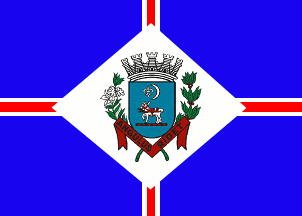 image by Dirk Sch÷nberger,
14 November 2012
image by Dirk Sch÷nberger,
14 November 2012Source: http://upload.wikimedia.org/wikipedia/commons/3/3c/Bandeira_de_Ita%C3%AD_SP.jpg

Last modified: 2012-12-09 by ian macdonald
Keywords: sao paulo | itanhaem |
Links: FOTW homepage |
search |
disclaimer and copyright |
write us |
mirrors
 image by Dirk Sch÷nberger,
14 November 2012
image by Dirk Sch÷nberger,
14 November 2012
Source:
http://upload.wikimedia.org/wikipedia/commons/3/3c/Bandeira_de_Ita%C3%AD_SP.jpg
Other sites:
The flag of Itanhaém is blue with a red cross bordered in white (officially
described as quartered per cross, the quarters being defined by four white stripes charged with red
overstripes). Overall, on a large white lozenge, is the municipal coat of arms, blue
with a white horse with red harness and blinkers and in chief a silver crescent and fleur-de-lis. The horse
is the crest from the arms of Vimieiros, honoring Countess Dona Mariana de Souza Guerra, who was a member
of that family and who provided the land on which the town was founded. The crescent
and fleur-de-lis are symbols of the patron saint, Our Lady of the Immaculate Conception--the original name of
the settlement was Conceição de Itanhaém. The colors are assigned the significance usual in
Brazilian municipal heraldry. Flanking the shield are branches
of tobacco and coffee. The scroll is inscribed, Angulus Ridet, meaning a happy corner or hiding
place.
Source: Official municipal website
Joseph McMillan, 4 September 2002
Official website at
http://www.itai.sp.gov.br
Dirk Sch÷nberger,
14 November 2012
Itanhaém was founded on 22 April 1532, being therefore the second oldest Brazilian town. The town was founded by Martim Afonso de Souza (c. 1500-1571), appointed Governor of Brazil by King of Portugal John III, who founded on 21 January 1531 the town of São Vicente, the oldest Brazilian town. The Captaincy of Nossa Senhora da Conceição de Itanhaém was established by Mariana de Souza Guerra, Countess of Vimeiros, on 8 February 1624, with it seat in Conceição de Itanhaém. The municipality of Conceição de Itanhaém was established on 20 October 1700. The name of the municipality was shortened to Itanhaém on 6 November 1906 by State Law no. 1,021. The municipality was granted the title of Sea Resort on 27 September 1948 b State Law No. 163.
The flag of Itanhaém is blue with a cross made a white stripe charged with a red stripe. In the middle is placed a white lozenge charged with the municipal coat of arms.
http://www.itanhaem.sp.gov.br/turismo/cidade/bandeira.html - Municipal website
Photos of the flag http://hugodilallo.blogspot.fr/2012/10/prefeitura-de-itanhaem-divulga.html http://3.bp.blogspot.com/_cVZfHFY3nYo/S9cYDHOVIUI/AAAAAAAAAdU/4G3SQThFyEY/s1600/DSC02140.JPG http://www.itanhaem.sp.gov.br/noticias/2012/abril/historia_itanhaem_tema_desfile_civico_comemoracao_480anos.html
The coat of arms of Itanhaém is "Azure a horse argent equipped gules in chief a fleur-de-lis argent and a crescent of the same. The shield surmounted by an eight-towered mural crown argent ports sable. The shield supported dexter by a plant of tobacco and sinister by a branch of coffee. Below the shield a right-angled scroll gules inscribed with the motto 'ANGULUS RIDET' argent."
The classic Flemish-iberic shield, aka Portuguese shield, recalls the inheritance of Brazilian heraldry from the colonizing nation, the main builder of the national identity. The eight-towered mural crown represent a second-rank town, seat of a "comarca". Azure is a symbol of justice, nobleness, perseverance, zeal, loyalty, beauty and recreation. The horse originally surmounted the coat of arms of the Vimieiros family, recalling that the town was founded on a 100-league plot of coastal land offered by Mariana de Souza Guerra, Countess of Vimeiros and niece of Martin Afonso de Souza. The fleur-de-lis and crescent represent the patron saint of the town, Our Lady of the Conception, and evokes the early settlement of Conceição de Itanhaém. Argent is a symbol of peace, work, friendship, audacity and courage.
Law No. 1,750 of 12 June 1991 prescribes the mandatory use of the flag in all municipal public buildings and in all classrooms of the municipal teaching network.
http://www.itanhaem.sp.gov.br/turismo/cidade/brasao.html - Municipal website
The Latin motto comes from a verse by Horace (Odes, Book II, Ode VI,
Verse 13), "Ille terrarum mihi prŠter omnes angulus ridet " (Of all
the corners of the world, there is none that so charms me), originally
referring to the countryside around Tarento.
Ivan Sache, 1 November 2012